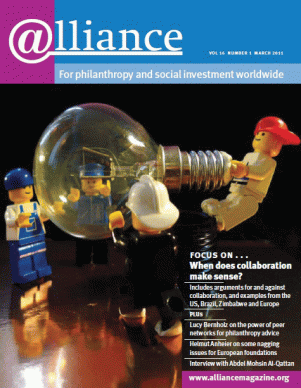Helmut Anheier’s ‘nagging’ of European foundations is welcome, not least because it is refreshing and gratifying to have an expert of his ilk make such an important foray through what is for once a European lens. Anheier is a keen analyst and scholar who knows the foundation scene well and is a ‘friendly’ critic. What, we wonder, will less benign and less informed critiques (which are inevitably on their way) look like?
The same charges from a less constructive vantage point could be very harmful, and this preemptive critique should prepare us for derisive attacks that our philanthropic community must be prepared to counter. Anheier has certainly provided us with some substantial food for thought – appropriate, seeing as he assumes that we enjoy having our cake and eating it too.
 The charges Anheier lays are manifold but, while our sector is far from critique-proof, we are not sure about some of the ‘deficit model’ arguments laid out. For brevity’s sake, it is probably best to dispense first with those criticisms we could concede to. It is fair to state unequivocally that academic knowledge and teaching on philanthropy in Europe is patchy. We sorely need more hardnosed researchers and analysts. It is also true that philanthropic infrastructure could, and should, be better supported by European foundations. Anheier, however, underestimates the major strides made by European foundations: in 2010, 86 per cent of the EFC’s funding came from European organizations. Finally, it is true that, historically, foundations have seemed somewhat shy to collaborate, but this trend is changing. Consider the Network of European Foundations, Fondazioni4Africa, European Consortium on Human Rights and Disability and Fondazione per il Sud, for example, and it becomes clear that Europe is now home to some of the best examples of effective philanthropic collaboration.
The charges Anheier lays are manifold but, while our sector is far from critique-proof, we are not sure about some of the ‘deficit model’ arguments laid out. For brevity’s sake, it is probably best to dispense first with those criticisms we could concede to. It is fair to state unequivocally that academic knowledge and teaching on philanthropy in Europe is patchy. We sorely need more hardnosed researchers and analysts. It is also true that philanthropic infrastructure could, and should, be better supported by European foundations. Anheier, however, underestimates the major strides made by European foundations: in 2010, 86 per cent of the EFC’s funding came from European organizations. Finally, it is true that, historically, foundations have seemed somewhat shy to collaborate, but this trend is changing. Consider the Network of European Foundations, Fondazioni4Africa, European Consortium on Human Rights and Disability and Fondazione per il Sud, for example, and it becomes clear that Europe is now home to some of the best examples of effective philanthropic collaboration.
While we recognize the underlying premise of Anheier’s criticisms, we take issue with some of his assumptions. Let’s immediately dispel the myth that European foundations ever laboured under the apprehension that they could, should, or would take on the role of the state. This is a red herring. Moving on, Anheier asserts that European foundations don’t see themselves as being ‘in it together’, part of something truly European, or keen to share experiences and lessons learned. Probably the 700+ delegates who attend the EFC Annual General Assembly and Conference each year would disagree: ours is a sector that is becoming increasingly interconnected. So, while we must strive to work even better together, especially in support of the European Foundation Statute (EFS), it is inaccurate to say that European foundations are ‘solo’ players.
The ‘flashy brochures that typically reveal little’ except the current ‘cause célèbre’ are obviously also points of concern for Anheier. To imply that foundations in Europe are merely fickle bandwagon-hoppers does not take into account the rich history and culture that European foundations are steeped in. Take, for example, Compagnia di San Paolo, which has been fighting for the rights of the underprivileged since 1563, or Svenska Kulturfonden, which has been supporting the cultural and educational activities of Finland’s Swedish-speaking population since 1908. Rather than being characterized as vacillating and unpredictable, we would contend that European foundations are known for their foresight and consistency.
Yet the acontextual prism and the things he did not mention surprised us most about Anheier’s critique. Arguments for and against introducing a mandatory 5 per cent payout rate are complex and too textured to delve into in this article; suffice it to say that bold assumptions that such a system would work in Europe are naive. Rather than jump to conclusions, we think we do need a serious debate on both sides of the Atlantic on this important issue. Moreover, for all the fuss made about transparency and accountability, it is a shame that the EFC Principles of Good Practice were not mentioned. Finally, Anheier also states that, ‘economically speaking’, foundations ‘make little difference’. However, the €83 billion to €150 billion that foundations in Europe contribute annually (which Anheier’s feasibility study on the EFS concluded) is a pretty sizeable slice of pie.
In conclusion, while we may not be in full agreement, Anheier’s critique is long overdue and enormously important. Hopefully readers will feel compelled to weigh in on the issues now that we are entering into an era in which philanthropic institutions may become fair game.
Gerry Salole is chief executive of the EFC. Email GSalole@efc.be
Luc Tayart de Borms is managing director of the King Baudouin Foundation. Email tayart.l@Kbs-frb.be





Comments (0)